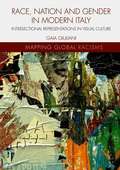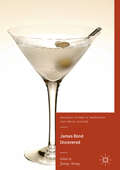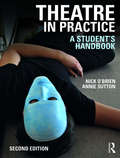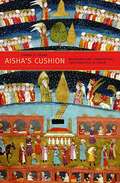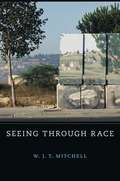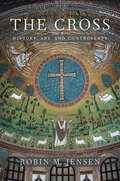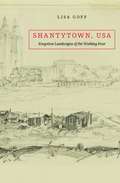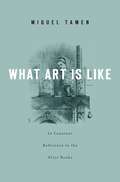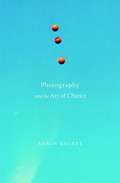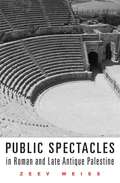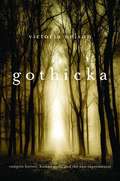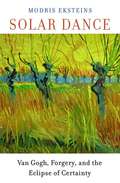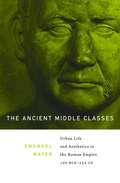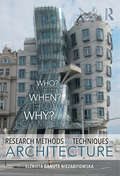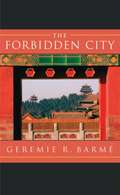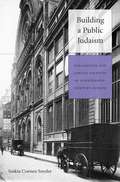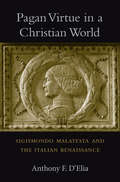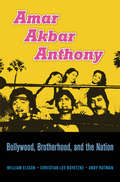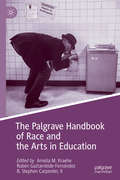- Table View
- List View
Letters of Light: Arabic Script in Calligraphy, Print, and Digital Design
by J. R. OsbornArabic script is one of the world’s most widely used writing systems, for Arabic and non-Arabic languages alike. J. R. Osborn traces its evolution from the earliest inscriptions to digital fonts, from calligraphy to print and beyond. Students of communication, contemporary practitioners, and historians will find this narrative enlightening.
Race, Nation and Gender in Modern Italy (pdf)
by Gaia GiulianiThis book explores intersectional constructions of race and whiteness in modern and contemporary Italy. It contributes to transnational and interdisciplinary reflections on these issues through an analysis of political debates and social practices, focusing in particular on visual materials from the unification of Italy (1861) to the present day. Giuliani draws attention to rearticulations of the transnationally constructed Italian ‘colonial archive’ in Italian racialised identity-politics and cultural racisms across processes of nation building, emigration, colonial expansion, and the construction of the first post-fascist Italian society. The author considers the ‘figures of race’ peopling the Italian colonial archive as composing past and present ideas and representations of (white) Italianness and racialised/gendered Otherness. Students and scholars across a range of disciplines, including Italian studies, political philosophy, sociology, history, visual and cultural studies, race and whiteness studies and gender studies, will find this book of interest.
James Bond Uncovered (Palgrave Studies In Adaptation And Visual Culture Series)
by Jeremy StrongThis volume brings fresh perspectives to the study of James Bond. With a strong emphasis on the process of Bond’s incarnation on screen and his transit across media forms, chapters examine Bond in terms of adaptation, television, computer games, and the original novels. Film nonetheless provides the central focus, with analysis of both the corpus as a whole—from Dr. No to Spectre—and of particular films, from popular and much-discussed movies such as Goldfinger and Skyfall to comparatively under-examined texts such as the 1967 Casino Royale and A View to a Kill. Contributors’ expertise and interests encompass such diverse aspects of and approaches to the Bond stories as Sound Design, Empire, Food and Taste, Geo-politics, Feminist re-reading, Tarot, Landscape and Sets.
James Bond Uncovered (PDF)
by Jeremy StrongThis volume brings fresh perspectives to the study of James Bond. With a strong emphasis on the process of Bond’s incarnation on screen and his transit across media forms, chapters examine Bond in terms of adaptation, television, computer games, and the original novels. Film nonetheless provides the central focus, with analysis of both the corpus as a whole—from Dr. No to Spectre—and of particular films, from popular and much-discussed movies such as Goldfinger and Skyfall to comparatively under-examined texts such as the 1967 Casino Royale and A View to a Kill. Contributors’ expertise and interests encompass such diverse aspects of and approaches to the Bond stories as Sound Design, Empire, Food and Taste, Geo-politics, Feminist re-reading, Tarot, Landscape and Sets.
Theatre in Practice: A Student's Handbook
by Nick O'Brien Annie SuttonTheatre in Practice is an accessible and wide-ranging exploration of the central practices and key practitioners covered on the various syllabi at A level, IB, BTEC and beyond. Exploring Stanislavski, Brecht, Artaud, Lecoq, Berkoff and Craig, as well as work from innovative theatre companies such as Complicite, Gecko and The Paper Birds, it combines an informal, unpretentious tone with a wealth of practical exercises. Revised and updated to meet the most recent post-16 and A level drama requirements and to include some of the latest practices in theatre, this new edition offers a step-by-step approach to developing key skills such as devising, improvising, rehearsing mono/duologues and directing plays. Written by specialists with extensive experience leading workshops for the post-16 age-group, Theatre in Practice is a thorough and imaginative resource that speaks directly to students. New for this edition: A new chapter exploring Artaud and how to use Artaud with text and when devising. A new chapter exploring the progression of practice from Lecoq to Complicite. A series of step-by-step exercises exploring the Gecko devising process. An exploration of the work of The Paper Birds and E G Craig when devising. New exercises on how to devise using Stanislavski and Brecht.
Aisha’s Cushion: Religious Art, Perception, And Practice In Islam
by Jamal J. EliasWesterners have a strong impression that Islam does not allow religious imagery. Elias corrects this view. Unearthing shades of meaning in Islamic thought throughout history, he argues that Islamic perspectives on representation and perception should be sought in diverse areas such as optics, alchemy, dreaming, vehicle decoration, Sufi metaphysics.
Seeing Through Race (The\w. E. B. Du Bois Lectures #11)
by W. J. MitchellAccording to Mitchell, a “color-blind” post-racial world is neither achievable nor desirable. Against claims that race is an outmoded construct, he contends that race is not simply something to be seen but is a fundamental medium through which we experience human otherness. Race also makes racism visible and is thus our best weapon against it.
The Cross: History, Art, and Controversy
by Robin M. JensenThe cross stirs intense feelings among Christians and non-Christians alike. Robin Jensen takes readers on an intellectual and spiritual journey through the 2,000-year evolution of the cross as idea and artifact, illuminating the controversies and forms of devotion this central symbol of Christianity inspires.
Shantytown, USA: Forgotten Landscapes Of The Working Poor
by Lisa GoffShantytowns once occupied a central place in America’s urban landscape. Lisa Goff shows how these resourceful dwellings were not merely the byproducts of hardship but potent assertions of self-reliance. Their legacy is felt in sites of political activism, from campus shanties protesting apartheid to the tent cities of Occupy Wall Street.
Elegy for Theory
by D. N. RodowickRhetorically charged debates over theory have divided scholars of the humanities for decades. In Elegy for Theory, D. N. Rodowick steps back from well-rehearsed arguments pro and con to assess why theory has become such a deeply contested concept. Far from lobbying for a return to the "high theory" of the 1970s and 1980s, he calls for a vigorous dialogue on what should constitute a new, ethically inflected philosophy of the humanities. Rodowick develops an ambitiously cross-disciplinary critique of theory as an academic discourse, tracing its historical displacements from ancient concepts of theoria through late modern concepts of the aesthetic and into the twentieth century. The genealogy of theory, he argues, is constituted by two main lines of descent--one that goes back to philosophy and the other rooted instead in the history of positivism and the rise of the empirical sciences. Giving literature, philosophy, and aesthetics their due, Rodowick asserts that the mid-twentieth-century rise of theory within the academy cannot be understood apart from the emergence of cinema and visual studies. To ask the question, "What is cinema?" is to also open up in new ways the broader question of what is art.
What Art Is Like, In Constant Reference to the Alice Books
by Miguel TamenThis comic, serious inquiry into the nature of art takes its technical vocabulary from Alice’s Adventures in Wonderland and Through the Looking-Glass. It is ridiculous to think of poems, paintings, or films as distinct from other things in the world, including people. Talking about art should be contiguous with talking about other relevant matters.
Photography and the Art of Chance
by Robin KelseyAs anyone who has wielded a camera knows, photography has a unique relationship to chance. It also represents a struggle to reconcile aesthetic aspiration with a mechanical process. Robin Kelsey reveals how daring innovators expanded the aesthetic limits of photography in order to create art for a modern world.
Public Spectacles in Roman and Late Antique Palestine (Revealing Antiquity Ser. #21)
by Zeev WeissWishing to ingratiate himself with Rome, Herod the Great built theaters, amphitheaters, and hippodromes to bring pagan entertainments of all sorts to Palestine. Zeev Weiss explores how the indigenous Jewish and Christian populations responded, as both spectators and performers, to these cultural imports, which left a lasting imprint on the region.
Gothicka: Vampire Heroes, Human Gods, And The New Supernatural
by Victoria NelsonThe Gothic has taken a revolutionary turn in this century. Today’s Gothic has fashioned its monsters and devils into heroes and angels and is actively reviving supernaturalism in popular culture. Nelson argues that this mainstreaming of a spiritually driven supernaturalism is a harbinger of what a post-Christian religion in America might look like.
Solar Dance: Van Gogh, Forgery, And The Eclipse Of Certainty
by Modris EksteinsArt dealer Otto Wacker’s 1932 sensational trial in Berlin for selling fake Van Goghs leads Eksteins to a unique narrative of a collapsing Weimar Germany, the rise of another misfit, Adolf Hitler, and the replacement of nineteenth-century certitude with twentieth-century doubt.
Chinese Calligraphy: An Introduction to Its Aesthetic and Technique, Third Revised and Enlarged Edition
by Yee ChiangThis is the classic introduction to Chinese calligraphy. In nine richly illustrated chapters Chang explores the aesthetics and the technique of this art in which rhythm, line, and structure are perfectly embodied. He measure the slow change from pictograph to stroke to the style and shape of written characters by the great calligraphers. It is a superb appreciation of beauty in the movement of strokes and in the patterns of structure--and an inspiration to amateurs as well as professionals interested in the decorative arts.
Cities of Words: Pedagogical Letters on a Register of the Moral Life
by Stanley CavellThis book--which presents a course of lectures Cavell presented several times toward the end of his teaching career at Harvard--links masterpieces of moral philosophy and classic Hollywood comedies to fashion a new way of looking at our lives and learning to live with ourselves.
The Ancient Middle Classes: Urban Life And Aesthetics In The Roman Empire, 100 Bce-250 Ce
by Emanuel MayerOur image of the Roman world is shaped by the writings of upper-class intellectuals. Yet most of the material evidence we have—art, architecture, household artifacts—belonged to artisans, merchants, and professionals. Roman culture as we have seen it with our own eyes is distinctly middle-class and requires a radically new framework of analysis.
CFE Higher Graphic Communication Course Notes (Course Notes for SQA Exams (PDF))
by Leckie Barry Forbes LeckieExam Board: SQA Level: Higher Subject: Graphic Communication First Teaching: 2014, First Exam: 2015 The Higher Graphic Communication Course Notes helps teachers and students map their route through the CfE programme, providing comprehensive and authoritative guidance for the course. • Full coverage of the new Higher course specifications with list of learning intentions • Attractive layout with clear text features • Key questions highlight crucial concepts and techniques that need to be grasped by students in order to progress to the next learning intention • What the examiner/assessor is looking for to help teachers & students feel secure • End of unit material – unit assessment, exam-style questions with worked answers and examiners commentary, self-assessment Course Notes give a practical, supportive approach to help deliver the new curriculum and offer a blend of sound teaching and learning with assessment guidance
Research Methods and Techniques in Architecture
by Elzbieta Danuta NiezabitowskaA scientific approach to architectural and architectonic research from the scope of just one discipline is no longer sufficient. With contemporary considerations such as behavior, health, and environmental protection, architects and students alike need holistic research methodologies that incorporate qualitative elements as well as more traditional quantitative ones. Research Methods and Techniques in Architecture examines research methodologies and tools applied in science and architectonic practice. Beginning with a thorough introduction to the main scientific, environmental, and architectural theories of the late twentieth century, the book guides the reader through the different aspects of architectural research design, building research teams, choosing applicable research methods, and representing research results.
The Forbidden City (Wonders of the World)
by Geremie R. Barmé Geremie BarméThe Forbidden City (Zijin Cheng) lying at the heart of Beijing formed the hub of the Celestial Empire for five centuries. Over the past century it has led a reduced life as the refuge for a deposed emperor, as well as a heritage museum for monarchist, republican, and socialist citizens, and it has been celebrated and excoriated as a symbol of all that was magnificent and terrible in dynastic China’s legacy.
Building a Public Judaism: Synagogues And Jewish Identity In Nineteenth-century Europe
by Saskia Coenen SnyderCoenen Snyder considers what the architecture and construction of nineteenth-century European synagogues reveal about the social progress of modern European Jews. The process of claiming a Jewish space was a marker of acculturation but not full acceptance, she argues. The new edifices, even if spectacular, revealed the limits of Jewish integration.
Pagan Virtue in a Christian World: Sigismondo Malatesta and the Italian Renaissance
by Anthony F. D'EliaIn 1462 Pope Pius II performed the only reverse canonization in history, damning a living man to an afterlife of torment. What had Sigismondo Malatesta, Lord of Rimini and a patron of the arts, done to merit this fate? Anthony D’Elia shows how the recovery of classical literature and art during the Italian Renaissance led to a revival of paganism.
Amar Akbar Anthony: Bollywood, Brotherhood, and the Nation
by William ElisonThe 1977 blockbuster Amar Akbar Anthony about the heroics of three Bombay brothers separated in childhood became a classic of Hindi cinema and a touchstone of Indian popular culture. Beyond its comedy and camp is a potent vision of social harmony, but one that invites critique, as the authors show.
The Palgrave Handbook of Race and the Arts in Education
by Amelia M. Kraehe Rubén Gaztambide-Fernández B. Stephen Carpenter IIThe Palgrave Handbook of Race and the Arts in Education is the first edited volume to examine how race operates in and through the arts in education. Until now, no single source has brought together such an expansive and interdisciplinary collection in exploration of the ways in which music, visual art, theater, dance, and popular culture intertwine with racist ideologies and race-making. Drawing on Critical Race Theory, contributing authors bring an international perspective to questions of racism and anti-racist interventions in the arts in education. The book’s introduction provides a guiding framework for understanding the arts as white property in schools, museums, and informal education spaces. Each section is organized thematically around historical, discursive, empirical, and personal dimensions of the arts in education. This handbook is essential reading for students, educators, artists, and researchers across the fields of visual and performing arts education, educational foundations, multicultural education, and curriculum and instruction.

